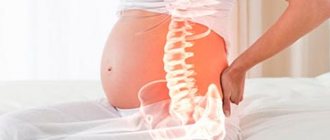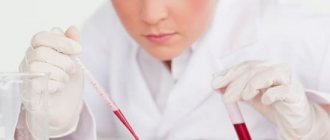From the moment the egg is fertilized and implanted in the uterine cavity, hormonal changes begin in the woman’s body, which will contribute to the preservation of pregnancy and its successful development. Previously released hormones change their concentration (progesterone and estrogen are produced more actively), which is expressed in different manifestations. The breasts are one of the first to react to hormonal changes. Very often, it is changes in the breasts and nipples that prompt a woman to think about the possibility of conception.
The breast begins to react to pregnancy from 10-14 days after conception, that is, virtually immediately after implantation of the egg. Moreover, both the breasts in general and the nipples in particular change. And this process lasts throughout the entire period of bearing the baby.
Increased nipple sensitivity during pregnancy
One of the very first signs of pregnancy
is an increase in nipple sensitivity. This feeling begins to simply irritate the woman: any touch to the nipple causes not only discomfort, but also infuriates her. Meanwhile, many women’s nipples become hypersensitive before each period, so often at this stage they still have no idea about anything, regarding this symptom as a manifestation of premenstrual syndrome.
But when you are already aware that you are pregnant, and your nipples hurt when pressed or touched, then it is better to immediately change your bra to the simplest and most comfortable one. The cup should be perfectly flat and smooth - without seams or decorative elements that irritate the nipples. Some doctors recommend placing pieces of coarse fabric in the cups, which will prepare the breasts for future feeding, and at the same time reduce their sensitivity and soreness.
Air baths will also have a beneficial effect on the chest and reduce soreness. Yes, and my husband will be pleased, to say the least. By the way, it’s not for nothing that nipples become hypersensitive: this is how they protect the breasts from now unnecessary stimulation, which can lead to the release of the hormone oxytocin, which causes uterine contractions.
Montgomery tubercles during pregnancy
Often, from the first weeks of pregnancy, a woman notices the appearance of small pimples around her nipples. These are the Montgomery tubercles, which are more correctly called glands. They are present in the nipple areolas of every woman, but become especially noticeable during pregnancy and breastfeeding.
The number of Montgomery glands can be very different - from a few pieces to multiple points around the nipple. But most often during pregnancy there are about 12 of them on each nipple. It is believed that the more tubercles, the more milk a woman will have.
Montgomery's tubercles are vestigial glands. It is not at all necessary that they manifest themselves during pregnancy, although it happens that they appear from the first days. In most cases, these glands hide after breastfeeding stops, although they often remain on the nipples. Don't worry about this - there's nothing wrong with it.
What will happen to the breast during pregnancy?
Every woman experiences breast changes differently. Each expectant mother's breasts may begin to change at different times. But there are still major changes in the mammary glands. What is changing?
- First of all, the volume of the breast changes. Already in the initial stages of pregnancy, breasts increase in size. Enlarged breasts are the first sign that conception has occurred. Hormones such as progesterone and estrogen affect breast growth; they provoke the growth of the milk ducts and connective tissue. Throughout pregnancy, a woman's breasts can change by two or three sizes.
- Breast sensitivity increases. Quite a lot of women have breast pain in the first month of pregnancy. The breasts become very sensitive, and even the lightest touch can cause an unpleasant feeling. This is explained by the fact that the breasts are intensively preparing to feed the baby.
- Colostrum is released. Colostrum begins to be released in the later stages of pregnancy. A thick yellow mass begins to come out from the nipples. Colostrum is commonly called the food of newborn babies, as it is produced at the very beginning of lactation. But in some cases, colostrum is also released during pregnancy.
- Stretch marks appear on the chest. Along with breast enlargement, stretch marks appear. This is due to the fact that the collagen fibers of the connective tissue may not withstand and tear during breast augmentation. Due to this process, dark red stretch marks form on the skin of the chest. After childbirth, they may become pale, but still the stretch marks do not disappear completely.
- Nipples change. During pregnancy, nipples may take on a brownish or dark red hue. The color of the areolas also changes. The areola can increase from 30 mm to 50 mm, and the nipple itself - from 9 mm to 12 mm. Nipples change color under the influence of melanocytes (skin cells that produce pigment). To date, there is no exact data on why the color of the areola and nipple changes, but there are suggestions that the dark color for a newborn baby is a kind of visual signal. Pimples may appear on the areola of the nipple, and a venous network may appear on the surface of the breast.
When a woman is pregnant, before the birth of the baby, she should begin to prepare her breasts for feeding the baby. It is best to make an appointment with a mammologist. He will be able to tell the woman how to properly perform breastfeeding and how to prevent stagnation of milk and injury to the nipples during feeding. It is also recommended to undergo an examination, because any tumor in the breast during pregnancy can grow significantly.
Every woman dreams of having beautiful and well-groomed breasts. To ensure that your breasts remain attractive and healthy after the birth of your baby, you should follow a few simple rules:
- You need to buy the right bra. The best option is a bra without wires and with wide straps. This particular model will provide good support to the breasts without squeezing them.
- You should apply anti-stretch mark cream to your chest every day. This cream can be purchased at almost any pharmacy.
- Strengthen your nipples. If a woman already has a child, then she probably knows how the baby’s gums can damage the nipples. To harden them a little, you need to give your nipples a contrast shower while the baby is pregnant.
- You need to take a shower every day.
Many women are interested in the question: is it possible to maintain breast shape when giving up breastfeeding? You need to know that the breasts begin to change already during pregnancy - even before the baby is born, the connective tissue begins to grow.
Colostrum production during pregnancy
Already from the second trimester, a pregnant woman may notice the release of colostrum from the nipples (clear, whitish or yellowish liquid), although most often this occurs closer to childbirth, in the third trimester. Hormones are again to blame for this, as they prepare the breasts for early feeding.
If you notice droplets of colostrum
, then under no circumstances squeeze it out of your chest. Just pat dry carefully and be sure to maintain good hygiene by showering twice a day. If the need arises, you can use chest pads. By the way, it is very useful to lubricate the nipples with a drop of colostrum - this prevents them from drying out and prevents the formation of cracks during feeding.
Nipple stimulation during pregnancy
And the last thing that cannot be ignored is nipple stimulation during pregnancy. Be extremely careful with this. Men really like the rounded shapes of their pregnant beloved wives. It’s simply a sin to leave such breasts unattended, but this may turn out to be unsafe. Stimulation of the nipples during pregnancy tones the uterus, which can provoke the threat of miscarriage or premature birth. In case of reversal of pregnancy
or in later stages, such natural
stimulation
may even be useful. But while the time for childbirth has not yet come, it is better not to take risks and not touch the nipples again.
It should be said that the described changes in the breasts and nipples will not necessarily manifest themselves. In some women, the breasts do not change at all until the birth itself, and only during the arrival of milk they begin to swell and harden. Do not worry if breast changes did not affect you during pregnancy - this is also normal. Each woman is individual, and her pregnancy proceeds differently from another.
The nipples have darkened, pain has appeared, or the areola has become deformed. In a woman, this can be a symptom of a pathological process, but also a sign of a joyful event for any couple - pregnancy.
For representatives of the stronger half of humanity, unexpected pigmentation of the nipples poses an increased danger. It indicates the development of a pathological process not only in the mammary gland, but also affects the adrenal glands and the brain.
Skin color depends on the amount of melanin pigment in the skin. Depending on life situations and the use of certain medications, melanin production may increase or decrease.
The skin of the mammary glands does not differ in structure from the skin on other parts of the body. Why does the pigmentation of this area of the body raise so many questions?
Reasons for nipple discoloration in women:
- pregnancy;
- use of hormonal contraceptives;
- treatment with other hormonal drugs;
- hormonal imbalance;
- breast carcinoma.
In women during pregnancy and general hormonal disorders, the color of the nipple and areola on both mammary glands changes simultaneously and equally. If one nipple has darkened, this indicates the beginning of an oncological process in the organ.
Causes of hyperpigmentation of the nipple or areola in men:
- gynecomastia is female-type enlargement of the gland. It is a harbinger of oncopathology;
- breast carcinoma;
- hormonal disorders in the pituitary gland or adrenal cortex.
All changes in the shape and size of the breast, nipple, and tissue color are not an independent symptom of either pregnancy or pathological changes in the organ.
Can nipple areolas darken not due to pregnancy?
The areola does not always darken because a woman is pregnant. Sometimes the same effect is observed with:
- Acute deficiency of vitamins B and D, folic acid.
- Hormonal disorders.
- Endometriosis.
- Uterine fibroids.
- Constant stress.
- Polycystic ovary syndrome.
Darkening of the nipples can also cause uncomfortable underwear. Therefore, you should choose a bra that is sized and has a design that is more comfortable to wear.
Changes in the sensitivity and appearance of the nipples during pregnancy occur due to hormonal imbalance. It is the new ratio of hormones in the blood that helps maintain pregnancy, prepare the body for childbirth and breastfeeding. A special role is given to estrogens, prolactin and progesterone.
Not every pregnant woman experiences unusual sensations in the chest; some are bypassed by this phenomenon. Both conditions are considered normal and do not affect subsequent lactation in any way. A woman should perceive the changes taking place with calm, and if she has any concerns, consult her doctor.
Usually changes are noted in the first trimester; at other times they can be caused by external factors:
- changing of the climate;
- weather change;
- weakened immunity;
- allergic reaction;
- consequences of taking medications.
Sometimes the cause of chest discomfort is a medical condition. It may be infectious in nature or result from a chronic process. Pathologies of the mammary gland during gestation include:
- thrush (a fungal disease whose pathogens are constantly present in the body, but are activated under certain circumstances);
- herpes infection (the pathogen is transmitted by contact or is latently present in the body);
- psoriasis (autoimmune dermatological disease);
- mastopathy (benign growth of breast tissue);
- oncological disease (malignant tumors).
To identify the cause of breast changes, you should consult a gynecologist. He will be able to accurately determine whether the disturbing symptoms are a sign of pathology or are completely normal. If necessary, the woman will be prescribed a special examination and consultation with a mammologist.
Causes of darkening during pregnancy
During pregnancy, the body begins to produce specific hormones, without which the development of the baby is impossible. These substances support pregnancy and have an immunosuppressive effect. The new hormonal status provokes increased production of melanin, and the nipples will darken during pregnancy.
Discoloration of the nipples and areolas begins in the first trimester and continues throughout the entire period of gestation and lactation. At the same time, the mammary glands enlarge, the shape and size of the nipple changes, and colostrum is released in the later stages. The peak of changes occurs at 37–38 weeks of pregnancy.
The color of the nipple during pregnancy depends on the individual characteristics of the body. For some women, these are shades of brown, for others, the areola turns black. This is a physiological condition. It does not require treatment or cosmetic correction.
Swelling of nipples, discoloration
During pregnancy, the breasts increase by 1-2 sizes, become full, heavy, the nipples swell and darken, their shape becomes more elongated and prominent. This prepares the breast for feeding a baby, who will be more comfortable latching onto a large, convex nipple.
During pregnancy, not only the nipples darken, the color of the mucous membranes on the genitals changes, a line appears from the navel to the pubis, and pigmented areas appear on the face (chloasma).
The darkening of the nipples and areolas occurs gradually, this is also influenced by estrogens (the hormone estriol), which promote the deposition of the melanin pigment, which gives the skin and mucous membranes a certain color. The appearance of tanning, freckles, moles, and age spots depends on it.
After childbirth, the skin condition returns to normal, but freckles and spots may appear when exposed to ultraviolet rays. It is better for pregnant women to refrain from being in the sun; on the beach, stay only in the shade or under cover.
Interesting! Some neonatologists say that a darker, brighter color of the areola quickly attracts the attention of a newborn baby. He orients himself better and finds a breast to feed; this becomes a condition for the formation of a conditioned reflex: he saw the breast and wanted to latch on.
Is pigmentation restored?
Independent restoration of the usual skin color on a woman’s mammary glands is possible only after cessation of lactation.
In all other cases, a change in color is possible only after identifying the cause of the change in melanin production. To do this, you should consult a doctor - for women a gynecologist or mammologist, for men - an andrologist and urologist.
Diagnostic activities are carried out according to the protocols of the World Health Organization. What is included in a standard examination for suspected breast diseases:
- examination and palpation of the gland;
- A family history is required. Particular attention is paid to cases of breast cancer in the patient’s relatives;
- Ultrasound to determine the shape, changes in the structures of the organ;
- mammography – x-ray examination of the breast;
- biopsy - in the presence of compactions, to determine the nature of the formation;
- MRI – for confirmed neoplasm in the mammary gland;
- nipple smear, blood and urine tests if a bacterial nature of the disease is suspected;
- blood test for hormones.
Pigmentation care
Caring for areas with increased pigmentation does not differ from the hygienic requirements for caring for the mammary gland.
- careful attitude towards the breast;
- use of comfortable underwear;
- do not use aggressive detergents and cosmetics;
- do not sunbathe topless either on the beach or in the solarium;
- follow the principles of healthy eating;
- If any warning signs appear - pain, bleeding or clear, purulent fluid - immediately contact a medical facility.
The best way to care for an area of hyperpigmentation without signs of a pathological process is to simply leave the skin alone and not focus on the dark spot.
Prevention of occurrence
During pregnancy, darkened nipples and areolas are a physiological norm and do not require specific prevention.
Outside the gestation period, the following recommendations will help prevent the appearance of hyperpigmentation foci:
- use high-quality and individually selected underwear;
- do not sunbathe with your chest exposed;
- try not to injure the delicate skin of the nipple;
- do not use hormonal drugs and oral contraceptives without a gynecologist’s prescription;
- periodically conduct self-examination of the mammary glands;
- undergo an ultrasound of the breast at least once a year; mammography is recommended for women over 40 years of age.
There is no need to search on forums why your nipples have darkened or turned black. Especially if hyperpigmentation affects only one mammary gland. No need to look for any folk recipes. See your doctor in the early stages of skin discoloration. This increases the chances of a full recovery!
Nipples, as well as a woman’s entire body, undergo changes during pregnancy, which can sometimes raise many questions. But every expectant mother should understand that the mammary gland is preparing for successful feeding of the child, and therefore the breasts become larger, the glandular tissue grows, making the breasts denser.
For more successful feeding, the nipples must enlarge and adapt to irritation, and all this must happen even before the baby is born. Changes in the nipples during pregnancy may include discharge, which can irritate the skin, cause itching and crust formation, and one should not exclude the possibility of diseases not related to the process of bearing a child, the symptoms of which must be recognized in time for timely consultation with a doctor.
Nipples undergo changes almost from the first days of pregnancy; almost every woman notices this at 5-6 weeks of pregnancy. If earlier a woman had nipples of a soft pink, light shade, then during pregnancy they become almost brown, dark in color. They often become too sensitive and sometimes hurt, which are the first classic signs of pregnancy.
Metamorphosis in the breasts occurs in the early stages, but by 20-25 weeks, many women notice slight colostrum, which again draws attention to the breasts. After childbirth and subsequent breastfeeding, the nipples begin to lighten and shrink, although they will no longer be the same as before pregnancy.
Female breast anatomy
Breast changes are a normal sign of a healthy pregnancy and are the result of hormonal changes.
Such changes begin to appear as early as a week after conception and can be observed until childbirth or longer. In this current article we will explain what happens to the mammary glands during each trimester. We'll also give you some tips for easing breast discomfort during pregnancy.
https://www.youtube.com/watch?v=3sTNL_Ze75Q
It is important to note that each woman’s breasts change differently during pregnancy. That is, not all of the symptoms listed below may be observed during this period.
From the moment a child is conceived until the 13th week of pregnancy, women can observe the following changes in their breasts.
Hormonal fluctuations may cause breast changes during pregnancy
Breast tenderness is one of the earliest symptoms of pregnancy.
- According to the US National Institute of Child Health and Human Development, women may begin to experience tenderness, heaviness, or tingling in their breasts as early as 1-2 weeks into pregnancy. The nipples may also become more sensitive and, in some cases, painful.
- These changes occur under the influence of increased hormonal levels in the body and increased blood flow to the breast tissue. Discomfort in this part of the body usually goes away after a few weeks, although it may return in the later stages of pregnancy.
Increase
A significant increase in breast size during pregnancy is normal, especially if a woman is preparing to give birth to her first child. Breast growth can begin early in pregnancy and continue as it progresses. A woman's breasts may become even larger during breastfeeding.
Sometimes rapid breast growth is accompanied by itching, as this process causes stretching of the skin.
The volume of blood in a woman’s body during pregnancy increases by almost 50%. As a result, blue veins begin to appear on several areas of the body, including the chest.
These veins are essential for a healthy pregnancy because they carry extra blood and nutrients that the developing fetus needs.
From 14 to 27 weeks of pregnancy, women can observe the following changes in their breasts.
Darkening of the areolas
Areolas are pigmented areas of skin that surround the nipples. During the second and third trimesters, areolas often become larger and darker. Some people believe that in this way nature makes it easier for the baby to find a source of mother's milk.
From a physiological point of view, darkening of the areolas is a consequence of hormonal changes. After breastfeeding ends, the areolas usually return to the color they were before pregnancy, but sometimes they remain slightly darker than they were originally.
Lumps on the areolas
Under the influence of pregnancy, painless protrusions begin to appear on the areolas. We are talking about oil-producing glands, which in medical practice are usually called Montgomery tubercles. They secrete a fatty substance that lubricates the breasts and makes breastfeeding easier.
Nipple discharge
For some women, nipple discharge begins to appear in the second trimester, for others, this change develops in the third trimester, and for others, only after childbirth. Discharge can occur at any time, but more often it occurs after breast stimulation.
Such discharge is yellow in color and has a thick consistency. They are referred to as colostrum and are a liquid that strengthens the immune function of newborns in the earliest stages of breastfeeding.
Lumps in the chest
Some women develop hard lumps in their breasts during pregnancy. In most cases, they do not indicate the presence of serious medical conditions and may indicate the following:
- galactocele - a cystic cavity filled with breast milk;
- fibroadenoma is a benign breast tumor.
Women need to remember that if any formations occur in the breast, they should definitely tell their doctor about it.
The risk of developing breast cancer during pregnancy is low, especially in women under 35 years of age.
However, during the period of bearing a child, doctors face more significant difficulties in diagnosing and treating this condition, and early contact with a specialist can significantly alleviate these problems.
Third trimester
From 28 to 40 weeks of pregnancy, women can observe the following changes in their breasts.
Continued growth
Many changes in the breasts that begin to occur in the first and second trimesters continue into the last months of pregnancy. The breasts may become even larger, even heavier, and the nipples may take on an even darker appearance. In this case, colostrum often begins to be released more often.
Stretch marks
Rapid tissue growth causes the skin to stretch, which can lead to the appearance of so-called stretch marks. Research has shown that between 50 and 90% of pregnant women deal with stretch marks, which most often occur on the thighs, abdomen and breasts.
Stereotactic breast biopsy: what you need to know?
Typically, women first notice this symptom in the sixth or seventh month of pregnancy, but it can occur earlier or later.
Milk production
The doctor will give the woman useful advice if she is concerned about problems with breastfeeding
All changes in the breasts of a pregnant woman occur in order to ensure feeding of the newborn.
- However, women who do not observe critical transformations in the mammary glands should not worry about their body’s ability to breastfeed. Changes in the nipples and breasts should not be taken as an indicator of such ability.
- Immediately after childbirth, and sometimes even earlier, the breasts begin to produce small amounts of colostrum. This liquid helps stimulate the baby's immune system. Newborn babies have very small stomachs and only need small amounts of colostrum.
- After a few days, milk begins to be produced in the breasts instead of colostrum. Breast milk production usually starts between the fifth day and the second week after birth.
If a woman is concerned about her ability to breastfeed her baby, she should discuss this with her doctor or lactation consultant.
Many women experience breast discomfort during pregnancy. However, there are measures that can be used to adapt to changes in the mammary glands and reduce discomfort.
To absorb colostrum, special pads should be inserted into the bra, which can be either disposable or reusable.
- By applying lotions and oils to your breasts, you can relieve tight and itchy skin. Many women also use similar products in the hope that they will help eliminate stretch marks.
- However, research published in 2014 by the British Journal of Dermatology found that topical medications such as cocoa butter and other oils did not prevent the development of stretch marks. Instead of using such treatments, experts recommend that women be patient because stretch marks and other skin changes usually disappear after the baby is born.
Women can treat blocked milk ducts by applying warm compresses to the painful and blocked areas of the breast.
Massage can also be beneficial in such cases. To achieve the effect, you should gently massage the breast in the direction from the painful area to the nipple.
During pregnancy, you should perform regular breast self-exams for signs of lumps and tell your doctor about any concerns or suspicions. In most cases, women are diagnosed with benign tumors. In addition, breast lumps may indicate clogged milk ducts.
Choosing a high-quality and comfortable bra is one of the best ways to reduce breast discomfort during pregnancy. When buying a bra, you should pay attention to the following points:
- good breast support;
- wide straps;
- adjustable fasteners;
- cotton fabric elements;
- absence of seeds;
- no seam in the nipple area.
Bras designed for sleep and sports are also suitable for wearing during pregnancy. Many women after childbirth prefer to purchase special nursing bras. They are also convenient to use during sleep and during pregnancy.
If a woman has already had several pregnancies, then it is associated with an increased risk of sagging breasts
- After childbirth, women continue to have increased breast size due to milk production.
- When breastfeeding ends, the breasts and nipples usually return to their original shape, size and color.
- For some women, this process occurs very quickly, but sometimes it takes a long time, and in some cases, the breasts never return to the appearance they had before pregnancy.
After carrying a child, your breasts may sag. Women who smoke or have other risk factors are at higher risk of experiencing this problem. These factors include the following:
- high body mass index;
- large breasts before pregnancy;
- previous pregnancies.
Women who are concerned about changes in their breasts during pregnancy should talk to their doctor about their concerns.
It is important to have a medical checkup if hard lumps form in the breasts or in situations where the nipples produce fluid that does not resemble colostrum. Such symptoms in most cases do not indicate harmful diseases, but should still be assessed by a doctor.
In most cases, during pregnancy, women experience changes in their breasts, which develop due to increased hormonal levels and increased blood volume in the body.
However, not everyone experiences such changes. If they are not observed, this does not mean that the woman has health problems or may encounter difficulties in breastfeeding in the future.
Changes in the breasts during pregnancy can cause discomfort. To effectively manage symptoms, women can buy comfortable bras, apply lotions to itchy skin, and use pads to absorb nipple discharge.
Nipple changes: normal or abnormal
Why does a change in nipple sensitivity occur in the early stages? Prolactin or lactation hormone is one of the hormones that allows you to maintain pregnancy, released at the very beginning of pregnancy in considerable quantities. Receptors for prolactin are also present in the mammary gland and nipples, which promotes rapid growth and development of the breast if its quantity increases. There is a sharp increase in blood circulation in the breasts, due to which it grows and swells, and the size of the nipple areolas increases significantly. Since the skin is not ready for such drastic changes, the nipples become too sensitive and sometimes painful.
Therefore, if during pregnancy your nipples itch, hurt, or you feel tingling and burning, these signs are normal for this “diagnosis.”
Of course, not every woman may have sore nipples; moreover, some do not even notice any changes in the breasts, which is also normal. But such indicators do not mean at all that there will be no milk, just that each organism is individual.
How to Reduce Discomfort Caused by Nipple Pain
Of course, every woman who is faced with the problem of excessive nipple sensitivity wants to somehow relieve the pain. You can reduce discomfort, first of all, by changing your underwear. It is necessary to choose a bra of the appropriate size made of soft cotton fabric.
Changing nipple color during pregnancy
Appearance of nipples during pregnancy
largely dependent on heredity. Nipples that are too flat can interfere with feeding, so to avoid such problems, the breasts must be prepared in advance.
In addition to the shape of the nipples, their color often also changes; they become darker, sometimes even brown. Reddening of the nipples is observed much less frequently; such metamorphoses are the norm for natural blondes with very fair skin.
Darkening of the nipples is caused by the deposition of the pigment melanin, which is produced in the skin under the influence of sex hormones. Nipples may darken either by 6-8 weeks or by the end of the 3rd trimester.
It is worth noting that the dramatic change in the nipples in the early stages may be less pronounced in the last weeks, since with the enlargement and stretching of the areola, the areola becomes lighter over time.
But, again, the color of the nipples may not change in all pregnant women; it all depends on the individual characteristics of the body.
Nipple discharge during pregnancy
However, it is still worth taking a break from breastfeeding a couple of months before giving birth.
Preparing for feeding
In principle, no special preparation for nipples is required; rather, you will need a psychological attitude towards it. Breasts require special preparation only if the nipples are flat and the areola is not stretchable and tight.
It also happens that before pregnancy the nipples were normal, but over time, instead of becoming protruding and lengthening, they, on the contrary, retract. In this case, the nipples will also need to be given attention, since the pregnancy period will allow them to train them to respond correctly to stimulation, but due to the release of oxytocin, such techniques can cause uterine contractions.
To strengthen the nipples, you can use stretching or rolling them between your fingers, but such massages should not be performed for more than a minute or with violence or aggression. If there is a threat of miscarriage, all kinds of massages and manipulations with the breast are contraindicated.
It’s worth remembering just one thing: it doesn’t matter whether your nipples are flat or not, since the baby is suckling, and therefore you can feed the baby in any case.
Nipple problems
During pregnancy, women often face the problem of dry nipples. Why is this happening? Dry nipples, just like other changes, can be caused by vitamin deficiency, for example, B vitamins or vitamin A. Peeling of the nipples often occurs in the last weeks, but some experience this already in the first months.
If nothing is done, cracks may form on the nipples, which is almost impossible to endure.
But dry, cracked and peeling nipples are a solvable problem. In this case, it is worth lubricating them with ointment for stretch marks. The resulting cracks can be healed either with sea buckthorn oil or bepanthen.
Today, in Russia, Purinal and Bepanten are more popular, but the whole world uses Lansinoh HPA lanolin ointment when breastfeeding, which has enormous advantages: it does not need to be washed off before feeding, the breasts almost instantly get rid of pain from cracks, and the skin of the nipples also breathes. It is not recommended to use soap when rinsing your breasts.
Moles and papillomas on the nipples during pregnancy
If there are moles or papillomas on the nipples, especially if they are located in such a way that during feeding it will be impossible to avoid them getting into the baby’s mouth, it is recommended to get rid of them.
You should not remove dark, flat moles, but you should definitely remove a convex papilloma before the baby is born, so as not to injure the breast when sucking.
In this case, you should consult a mammologist. You can get rid of such formations even during pregnancy.
Symptoms that require you to see a doctor
- the nipples changed color, the skin over them turned sharply red and its temperature increased;
- the discharge is not normal (greenish, has an unpleasant odor, blood and other discharge that is not clear to you);
- Nipple sensitivity during pregnancy is normal, but the feeling of pain should not be constant; only both breasts can hurt;
- If during pregnancy the nipples suddenly turn white, for example due to hypothermia, similar symptoms are expressed in Raynaud's syndrome.
Doctors consider nipple pain, swelling, darkening, enlargement, and other unusual symptoms as normal for a woman during pregnancy.
But these manifestations should not be neglected or ignored - when the pain in the nipples is constant, severe, when they peel, tingle, dry, crack, itch, turn black and cause discomfort to the pregnant woman, you need to consult a doctor to find out the causes of the condition and alleviate the symptoms.
What does it mean if there are no changes?
Some girls are worried about the lack of changes in their breasts. Experts believe that this phenomenon is normal. The fact is that pregnancy progresses differently for everyone. Some, from the first days after conception, feel intensive growth of the mammary glands, they hurt and itch (more details in the article:). Other women don't feel this at all.
In both cases, preparation for lactation occurs. Doctors cannot say with certainty that nipple swelling and darkening in any way affects the amount of milk produced. Most likely, there is no such relationship, so there is no need to worry.
One of the indirect signs of pregnancy is darkening of the nipples already in the early stages, and as pregnancy progresses, the nipples darken even more and enlarge along with the mammary gland.
Why do women's nipples darken?
Darkening of the nipple in pregnant women can be expressed to varying degrees; it intensifies under the influence of sunlight and decreases after the birth of the child. Brunettes with dark skin will have darker nipples than blondes with light skin. In some cases, after pregnancy the pigmentation remains but decreases, and pink nipples before birth may remain brown afterwards.
Why do my nipples turn dark during pregnancy?
Women often wonder why the nipples are dark during pregnancy and what causes pigmentation in other areas of the skin. After all, darkening can occur not only in the nipple and areola around it - the white line of the abdomen and the skin around the eyes darken, the pigmentation of the skin of the labia increases, new freckles and freckles may appear on the face, which darken in the sun.
During pregnancy, due to hormonal disorders, stress, as well as a lack of B vitamins and folic acid, excess production of the melanin pigment in a woman’s body can be observed. But, even with a sufficient amount of vitamins and the absence of stress and toxicosis, a woman’s nipples can darken significantly. After all, heredity remains an important factor contributing to the development of pigmentation during pregnancy.
How to reduce nipple pigmentation?
If the nipples begin to darken, women start taking vitamins, which no longer have an effect. Usually, before giving birth, the only recommendation for a woman who wants to reduce skin pigmentation may be advice to spend less time in the sun and avoid ultraviolet irradiation (although to prevent inflammation and cracked nipples after childbirth, the doctor may recommend UV irradiation of the nipples, which will also slightly increase pigmentation).
And after childbirth, pigmentation itself begins to decrease. But to speed up this process, you can use ointments and creams that lighten the skin. However, you should avoid cosmetics containing hydroquinone, despite its effectiveness in reducing skin pigmentation. Among the folk remedies for skin lightening, women use parsley, cucumber, lemon, strawberry or wild strawberry juice, grapefruit, pomegranate, as well as birch sap.
From the moment the fertilized egg is implanted in the uterine cavity, dramatic changes begin in the body of the expectant mother, which will help her when bearing a child. The hormones that the body previously produced change their concentration (estrogen, progesterone become more active), which is expressed in various manifestations. Changes in the breasts very often lead a woman to think that conception was probably successful.
The breast begins to react to pregnancy already from 10-15 days after fertilization, that is, after implantation of the egg. Not only women's breasts undergo changes, but also their nipples. This process lasts until the end of pregnancy, and a short period of time after the birth of the baby (about 2-7 days).
Why do nipples hurt during pregnancy?
In medicine, there is a concept of subjective, objective and probable signs of pregnancy. For example, changes in emotional state and sore nipples are classified as subjective signs. Is it only during pregnancy that nipples swell and hurt? No.
Breasts swell and nipples hurt:
- in the middle of the cycle, before ovulation;
- during the premenstrual period (PMS);
- if protected with oral contraceptives.
Gynecologists often encounter complaints from pregnant women about pain in the mammary glands from the inside and outside. Although this problem is not fatal, it significantly reduces the quality of life. After all, a pregnant woman is also a wife.
Physiological reasons
A woman's body prepares for pregnancy every month. As soon as conception occurs, the concentration of some hormones increases and others decrease. Progesterone, or popularly the “pregnancy hormone,” affects the skin, adipose, nervous tissue and blood vessels. Its influence is needed to prepare for bearing a baby.
A woman notices that she begins to run to the toilet frequently, that she feels sick in the morning, and in the evening she suddenly wants to eat chalk. This is not a nervous disorder, this is pregnancy!
Remember! Increased breast sensitivity and pain in the nipples, heaviness in the lower abdomen, morning sickness - these are the first signs that you are pregnant.
Thanks to prolactin and progesterone, breasts increase by 2-3 sizes. This is especially pleasing for women with small sizes. Many ladies even take photos of their breasts and pregnant belly during pregnancy or arrange a candid photo shoot.
However, enlarged breasts add not only sexuality, but also discomfort. In the early stages, nipples may not change in appearance in any way, they will simply be hypersensitive. And at the end of the second and beginning of the third trimester, under the influence of prolactin, colostrum begins to be produced - blood flow in the breast increases, the milk ducts expand, and the shape of the nipple changes. Increased pressure and tension can be perceived by receptors as a pain impulse.
Colostrum is a few drops of yellow color, pre-milk. The breasts seem to be “training” before real feeding. Showering twice a day and using a moisturizer (oil or cream) will prevent dry, crusty nipples.
Since colostrum can wet your clothes, we recommend purchasing a special nursing bra with absorbent pads. It is only important to regularly change the gaskets and arrange air baths so as not to create an environment for the growth of bacteria.
Pathological causes
Dryness and stretching of the skin on and around the nipples leads to cracks, pain and infection in the milk ducts. The feeling of itching and burning prompts a woman to touch the skin and scratch it. When you press on the painful area, blood sometimes comes out. All this creates micro-tears in the epithelium, the protective barrier of the skin collapses and bacteria or viruses penetrate inside.
So unpleasant sensations in the mammary glands can also signal serious problems.
Infections that most often cause gravidar, i.e. “pregnant” mastitis:
- streptococci - liquid flows from the nipples, honey-colored, with an unpleasant odor;
- staphylococci - signs of intoxication, prolonged course;
- herpes virus type 1 manifests itself as bubbles (they look like pimples on the chest), which then collapse and a crust forms on top;
- E. coli - classic signs of inflammation;
- fungi of the genus Candida - cheesy discharge with a sour odor, which also occurs in immunocompromised conditions (for example, HIV).
Laboratory tests will help determine the source of infection.
External influencing factors
Besides infections and hormones, could there be other causes of pain in the mammary glands?
Certainly:
- Shower gel dries out the delicate skin of the areolas and nipples.
- A bra with a seam opposite the nipples or simply made of rough fabric. If you didn’t pay attention to this before pregnancy, you will now experience discomfort due to increased sensitivity.
- Allergies to moisturizing creams and lotions are manifested by itching, burning, redness of the skin, nipples “burn” as if they may peel off.
Change the bra manufacturer, wear special underwear for pregnant women.
Let's watch the video:
Formation of cracks
During pregnancy, the water-electrolyte balance in the body is disrupted, blood pressure changes, and swelling occurs. The skin may dry out and peel, especially on exposed areas of the body, face and hands. The body does not have enough vitamins and minerals, hair and nails become brittle. For the same reasons, cracks in the nipples may appear, they increase in size, the skin does not receive enough nutrients and does not have time to be evenly distributed.
To eliminate dryness, peeling and cracks, you should regularly take therapeutic and preventive measures.
- Choose the right dosage of multivitamins or vitamin-mineral complexes. The point is not to increase the dosage, but to choose exactly what the body lacks. The debate about the benefits of synthetic and “natural” vitamins continues in the scientific and pharmaceutical industries, so we will leave this issue for a separate consideration.
- Use moisturizing creams, ointments, lotions - there is a huge choice, starting from affordable skincare cosmetics for 50 rubles. to premium offers for 500 rubles. Again, we will not continue the discussion about how effective the advertised products are. As a last resort, you can use Vaseline or glycerin; they are practically hypoallergenic.
For treatment and daily care of nipples that have cracks, you can use the following medications:
- Ointments with panthenol (Bepanten, Dexpanthenol, Pantoderm, etc.) – relieve pain, relieve inflammation and irritation of the skin, soften and moisturize the skin.
- Levomekol, Levomethyl - healing ointments, the antibiotic chloramphenicol prevents the spread of bacteria, dioxomethyltetrahydropyrimidine accelerates the regeneration of damaged tissues.
- Methyluracil ointment stops infection and promotes rapid healing.
- Zinc ointment - used for dermatitis, diaper rash, inflammatory rashes.
Often pregnant women use cosmetic vegetable oils (wheat germ, sea buckthorn, rose hips). Lubricate the nipples 2-3 times a day with soft, circular movements or simply apply the oil with a cotton swab and leave until completely absorbed.
Why do nipples darken and itch during pregnancy?
From posts on thematic forums: “Why do I have black nipples?” “My husband said in surprise that my nipples and areolas began to darken. Is this how it should be?
No need to worry!
Nipple pigmentation is a normal physiological process. In some women they become almost black, while in others they become slightly brownish. This usually happens at 4-5 months.
But why do they get dark? Endocrine organs - the pituitary gland, adrenal glands and placenta produce hormones, and they, in turn, influence biochemical processes in the body. Melanocyte-stimulating hormone and estrogens stimulate the production of melatonin in melanocytes.
Melatonin is produced not only under the influence of UV rays, but also under the influence of heat. During gestation, the belly and chest of the expectant mother stretch, blood circulation increases, and the synthesis of melatonin in melanocytes is stimulated. In addition, it is an antioxidant and protects the epithelium from harmful influences.
The body's immune strength decreases, allowing the embryo to take root. Therefore, you need to be more careful about your hygiene during this period. Darkening and swelling are often accompanied by unpleasant symptoms indicating inflammation.
The signs are as follows:
- yellow, foul-smelling discharge from the nipple;
- painful cracks, peeling;
- swelling, increased body temperature, burning nipple;
- blood comes out when pressed;
The symptoms clearly indicate that you need to make an appointment with a doctor.
Treatment of a bacterial infection is carried out with antibiotics that do not penetrate the placenta, that is, they do not harm the fetus. On the Internet you can find many myths about the treatment of mastitis with folk remedies. But there is no better way to cure mastitis than antibacterial therapy, if it is not phlegmonous or gangrenous forms. Severe mastitis can only be treated with surgery. So consult your doctor promptly.
There are infections that manifest themselves as intoxication, and there are also those that do not cause an inflammatory reaction, but have peculiar clinical manifestations. For example, human papillomavirus. The clinical picture is as follows: small papillomas on the nipples, armpits, inguinal folds, and on the skin of the genitals.
Does this virus always manifest itself? Of course, not 100% of pregnant women develop papillomas. Some people confuse them with white raised dots. They are especially noticeable when the nipple shape changes to cylindrical. These are Montgomery's glands. They are believed to secrete a lubricant that protects the areola and nipple.
Normal and pathological symptoms
The above symptoms, within normal limits, are expressed in different women in different volumes and combinations. For some, pregnancy does not show any external signs at all.
But if alarming indicators are noticeable, it is better to consult a doctor immediately:
- asymmetrical nipple size or color;
- bluish tint of nipples and areolas
- the appearance of dark spots on the areolas;
- discharge from the nipples is purulent or bloody;
- the presence of atypical nodules and seals.
If there is a high temperature, abdominal pain, or copious discharge from the genital tract, you should call an ambulance or take all measures for urgent hospitalization.
Attention! Nowadays the Internet movement and the current trend among women are “Home birth”, “Giving birth without a doctor” and the like. The point is to refuse observation at the clinic, not to attend the antenatal clinic, where doctors prescribe “harmful” tests and medications. From a rational point of view, this is not justified in any way, but leads to pathological results in the woman in labor and the baby.
How to prepare your breasts for feeding
- If a woman has hypersensitive nipples, the doctor may recommend gently massaging the nipples with a cotton glove while showering. This is necessary so that the baby does not cause suffering to the mother when sucking the nipples.
- You can do a massage without gloves - you need to stroke your breasts in a circular motion, without applying pressure.
- If your nipple shape is flat or inverted, it will be difficult for your baby to latch on to the breast. If your nipples do not change shape early in your pregnancy, talk to your doctor about purchasing special nipple pullers to stimulate your nipples.
- Buy cream with dexpanthenol or lanolin in advance. For example, Bepanten. Domestic analogues - Panthenol Evalar, Dexpanthenol, Pantoderm.
There are special gels and ointments for nipples during pregnancy and lactation. Don't neglect them. In old obstetrics textbooks you can find recommendations to smear nipples with brilliant green or even alcohol. We strongly recommend not to do this; dry out the skin and mucous membranes even more.
There is one disease that worsens the life of both mother and newborn. This is mastitis. It is not difficult to avoid if you take care of your body correctly.
Why nipples should not be touched during pregnancy
During pregnancy, hormonal levels change significantly. Almost all organs, including the brain, are aimed at bearing and preserving the fetus. At the same time, there are hormones that are conventionally called labor hormones. One of them is oxytocin. You may have heard of it as the joy hormone, but in fact this substance has other functions. It contracts striated and smooth muscles, inducing labor and reducing blood loss.
This hormone is released if you stroke and twist the nipple for a long time. Therefore, in the third trimester, in particular at 36, 37, 38 weeks, it is better not to touch the nipple. Sexual rest is recommended in the last three months before childbirth.
In obstetrics, there is a practice of rubbing the nipples if a woman is post-term (more than 40-41 weeks) or labor has slowed down during labor.
Prevention of painful sensations - how to avoid them
Here are tips to help you get through your entire pregnancy without any problems:
- Maintain a water regime - clean water 10 ml per kg of body per day. If there is no swelling.
- Swap gels with fragrances for liquid baby soap or gels with a minimum of surfactant additives.
- Don't neglect breast hygiene and nursing bras.
- Ointments with dexpanthenol, lanolin and zinc will relieve dryness and crusts on the nipples.
- If cracks have already formed, then a cream with vitamin A will restore the epidermis. But it cannot be combined with taking retinol orally.
- Are your breasts very red and sore, and is pus flowing from your nipple? Is there an unpleasant odor coming from your breasts? Contact your gynecologist immediately, he will prescribe an antibacterial ointment.
- Air baths are necessary for the chest. But no more than 15 minutes a day and not under air flow.
- And avoid hypothermia. Sometimes it’s easier to spend money on a taxi if there is no transport for a long time than to buy medications for fever that will harm the baby.
How to reduce discomfort
All these manifestations of pregnancy are natural and do not require special intervention. After birth, the condition of the breasts and nipples corresponds to the infant's feeding regimen. With prolonged lactation, the mammary glands can be enlarged for 1.5-2 years.
In order to alleviate the condition of a pregnant woman, you need to follow simple recommendations.
- It is better to choose the “right” size underwear that supports the breasts well but does not put pressure, it is better with wide straps.
- Wear loose clothing made from natural fabrics that does not compress the chest or restrict movement.
- Use breast moisturizers and anti-stretch marks medications.
- Regularly visit a gynecologist, mammologist, and other specialized specialists (especially a urologist, cardiologist, phlebologist), and follow all instructions.
- Follow a diet for pregnant women and a drinking regimen to reduce swelling and normalize blood pressure.
- Choose the optimal mode of work and rest, so as not to strain, not to be nervous, try to sleep on your back or side.
- Continue as much physical activity as possible - exercise best stimulates blood flow, relieves muscle tension, and strengthens ligaments.
You need to devote more time to relaxation and creative hobbies that bring pleasure, then the hormonal system is “balanced” and attention is transferred to more interesting activities. The notorious “knitting caps” stimulates nerve receptors, the brain switches to a labor-intensive process and “forgets” about other stimuli.









